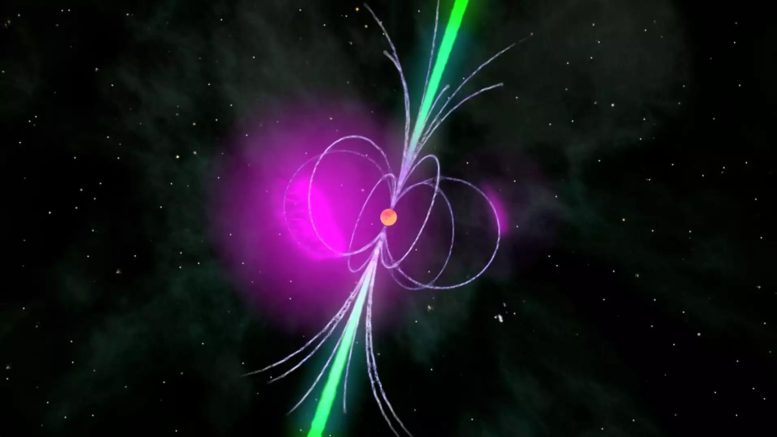
A gamma-ray pulsar is a compact neutron star that accelerates charged particles to relativistic speeds in its extremely strong magnetic field. This process produces gamma radiation (violet) far above the surface of the compact remains of the star, while radio waves (green) are emitted over the magnetic poles in the form of a cone. The rotation sweeps the emission regions across the terrestrial line of sight, making the pulsar light up periodically in the sky. Credit: NASA/Fermi/Cruz de Wilde
By employing new optimal algorithms on their ATLAS computer cluster to help go through Fermi data, scientists from the Max Planck Institute discovered the 5,000 year old gamma-ray pulsar J1838-0537.
Pulsars are superlative cosmic beacons. These compact neutron stars rotate about their axes many times per second, emitting radio waves and gamma radiation into space. Using ingenious data analysis methods, researchers from the Max Planck Institutes for Gravitational Physics and for Radio Astronomy, in an international collaboration, dug a very special gamma-ray pulsar out of data from the Fermi Gamma-ray Space Telescope. The pulsar J1838-0537 is radio-quiet, very young, and, during the observation period, experienced the strongest rotation glitch ever observed for a gamma-ray-only pulsar.
Pure gamma-ray pulsars are difficult to identify because their characteristics, such as their sky position, the period of rotation, and their change in time, are unknown. And astronomers can only determine their approximate position in the sky from the original Fermi observations. They must therefore check many combinations of these characteristics in a blind search, which requires a great deal of computing time. This is the only way of finding a hidden periodicity in the arrival times of the gamma-ray photons.
Even high-performance computers quickly reach their limit in this process. Therefore, the researchers used algorithms originally developed for the analysis of gravitational-wave data to conduct a particularly efficient hunt through the Fermi data. “By employing new optimal algorithms on our ATLAS computer cluster, we were able to identify many previously-missed signals,” says Bruce Allen, Director of the AEI. Back in November 2011, Allen’s team announced the discovery of nine new Fermi gamma-ray pulsars, which had escaped all previous searches. Now the scientists have made a new extraordinary find with the same methods.
The name of the newly discovered pulsar – J1838-0537 – comes from its celestial coordinates. “The pulsar is, at 5,000 years of age, very young. It rotates about its own axis roughly seven times per second and its position in the sky is towards the Scutum constellation,” says Holger Pletsch, a scientist in Allen’s group and lead author of the study which has now been published. “After the discovery we were very surprised that the pulsar was initially only visible until September 2009. Then it seemed to suddenly disappear.”
Only a complex follow-up analysis enabled an international team led by Pletsch to solve the mystery of pulsar J1838-0537: it did not disappear, but experienced a sudden glitch after which it rotated 38 millionths of a Hertz faster than before. “This difference may appear negligibly small, but it’s the largest glitch ever measured for a pure gamma-ray pulsar,” explains Allen. And this behavior has consequences.
“If the sudden frequency change is neglected, then after only eight hours, a complete rotation of the pulsar is lost in our counting, and we can no longer determine at which rotational phase the gamma-ray photons reach the detector aboard Fermi,” adds Pletsch. The “flashing” of the neutron star then disappears. If the researchers take the glitch into account and correct the change in rotation, the pulsar shows up again in the observational data.

The gamma-ray pulsar J1838-0537 found at the Albert Einstein Institute in Hanover is located towards the Scutum constellation, which is above the southern horizon in the summer sky. This detailed map shows the position of the pulsar (yellow), which is invisible to terrestrial telescopes, in a simulated view of the sky. Credit: stellarium/AEI/Knispel
The precise cause of the glitches observed in many young pulsars is unknown. Astronomers consider “star quakes” of the neutron star crust or interactions between the superfluid stellar interior and the crust to be possible explanations. “Detecting a large number of strong pulsar glitches makes it possible to learn more about the inner structure of these compact celestial bodies,” says Lucas Guillemot from the Max Planck Institute for Radio Astronomy in Bonn, the second author of the study. “This is a good example of the collaboration of two Max Planck institutes with complementary research foci,” says Michael Kramer, Director and Head of the Fundamental Physics in Radio Astronomy research group.
After the discovery in data from the Fermi satellite, the researchers pointed the radio telescope in Green Bank, West Virginia/USA at the celestial position of the gamma-ray pulsar. In an observation of almost two hours and by analyzing a further, older, one-hour observation of the source they found no indications of pulsations in the radio range, indicating that J1838-0537 is a rare gamma-ray-only pulsar.
There were, however, noticeable overlays with observations of the High Energy Stereoscopic System (H.E.S.S.) in Namibia, which searches for very-high-energy gamma radiation from the depths of space. In a survey with H.E.S.S., astronomers found an extended source of this radiation near the now discovered pulsar, but have not yet been able to clarify its nature.
The discovery of the pulsar suggests that the H.E.S.S. source is a pulsar wind nebula. These are produced by particles moving at almost the speed of light, which the pulsar accelerates in its extremely strong magnetic field. Since the exact position of the pulsar is now known, H.E.S.S. can take this into account in the future and to make more precise measurements than before in this celestial region.
The ATLAS computer cluster of the Albert Einstein Institute has thus already assisted in the discovery of the tenth previously unknown gamma-ray pulsar; however, Allen’s team has meanwhile mobilized further computing capacity. “Since August 2011, our search has also been running on the distributed computing project Einstein@Home, which has computing power a factor of ten greater than the ATLAS cluster. We are very optimistic about finding more unusual gamma-ray pulsars in the Fermi data,” says Bruce Allen. One goal of the expanded search is to discover the first gamma-ray-only pulsar with a rotation period in the millisecond range.
Reference: “PSR J1838−0537: Discovery of a Young, Energetic Gamma-Ray Pulsar” by H. J. Pletsch, L. Guillemot, B. Allen, M. Kramer, C. Aulbert, H. Fehrmann, M. G. Baring, F. Camilo, P. A. Caraveo, J. E. Grove, M. Kerr, M. Marelli, S. M. Ransom, P. S. Ray and P. M. Saz Parkinson, 27 July 2012, The Astrophysical Journal Letters.
DOI: 10.1088/2041-8205/755/1/L20









Be the first to comment on "Newly Discovered Gamma-Ray Pulsar J1838-0537"